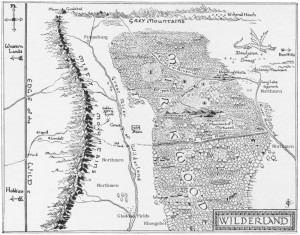Q: How Does Mirkwood Exist on the East Side of the Mountains?
ANSWER: Some readers have noted that Mirkwood — lying very far inland from the sea — seems to defy what we know about forests and mountains. That is, Mirkwood is separated from the sea by two mountain ranges and the vast expanse of Eriador, so is it plausible that Mirkwood should receive much rainfall?

There are, in fact, desert regions in the western United States and northern Africa where mountain systems block seaside rains from falling in the lands to the east. But climate is not always that simple. There are forests, for example, in western states within a few hundred miles west of the Mississippi river, which separates the Great Plains of North America from the eastern forests and Appalachian mountains. Rivers can have a huge impact on climate. The Rio Grande runs south through Albuquerque, New Mexico, creating a narrow “green zone” that supports many trees and lush shrubs and grasses within a few miles of the river. The Rio Grande is only a fraction of the size of the Mississippi river.
Any desert or arid region can experience a rich amount of rainfall if there are sufficient local sources for evaporation that clouds build up locally and return their rain to the lands. Hence, large river systems like the Nile and the Mississippi can create huge green zones without supporting rains from the sea.
Does that mean Tolkien’s Mirkwood is plausible? It’s hard to say. After all, he planted mitigating factors around the map. Not only does the Anduin lie to the west of Mirkwood, the Celduin (River Running) lies to the east of the great forest — and there is a river running through the forest itself, coming down out of the Grey Mountains to the north.
While geographers and geologists might argue one way or another, at the end of the day we know that Tolkien constructed Mirkwood as a landscape for some of his stories. The stories had to take priority over the practicalities of science. J.R.R. Tolkien certainly went to some lengths to make many elements of his stories plausible but not everything is perfect. I think it is enough that he understood how climate can be affected by mountains and tried to show there were mitigating factors.
# # #
Have you read our other Tolkien and Middle-earth Questions and Answers articles?

Mirkwood is probably too cold for a significant amount of evaporation so the trees use most of the moisture.
The Mountains of Mirkwood and Dol Gulder are probably tall enough to produce their own orographic lifting and receive plenty of rain/snow. Dol Gulder must be cold and wet enough to support (though poorly)” a forest of dark fir.”